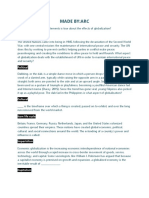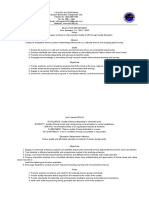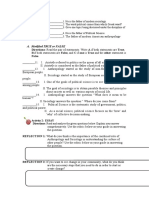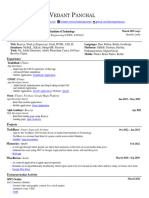Contemporary World Pre-Final Exam
Contemporary World Pre-Final Exam
Uploaded by
Ace Shernyll Son GallanoCopyright:
Available Formats
Contemporary World Pre-Final Exam
Contemporary World Pre-Final Exam
Uploaded by
Ace Shernyll Son GallanoOriginal Description:
Original Title
Copyright
Available Formats
Share this document
Did you find this document useful?
Is this content inappropriate?
Copyright:
Available Formats
Contemporary World Pre-Final Exam
Contemporary World Pre-Final Exam
Uploaded by
Ace Shernyll Son GallanoCopyright:
Available Formats
AMA Computer Learning Center College
Real St. Tacloban City
Pre-Final Examinations in Contemporary World
Test I. Read the statements carefully then choose the letter of the correct answer from
the choices given.
1. The three demographic processes are: (B)
a. Reproduction, marriage, and divorce b. Births, deaths, and marriage
c. Fertility, mortality, and migration.
2. Demography is the systematic and _______ study of human ________. (C)
a. social, characteristics b. scientific, characteristics c. scientific, populations
3. Population structure is defined as: (C)
a. How many people there are in a given place
b. Where people are located and why.
c. How many males and females there are of each age
4. Through mass media, people learn about: (A)
a. Material culture b. Non-material culture c. a & b
1. Social class is based on social factors like: (C)
a. Wealth/income b. education c. all of the above
2. Two ways of innovations are: (C)
a. discover it b. innovate it c. a & b
3. What is the main reason of transition to an information technology? (B)
a. Computers b. Software c. Communication
4. Cross cultural development and exchange of technology is called: (B)
a. Media globalization b. Technological globalization c. globalization
5. Moral development is an important part of: (A)
a. socialization b. industrialization c. modernization
6. Which system socialize our society? (C)
a. Economic b. Political c. Educational
7. Most valuable goods of modern era is: (C)
a. Modernization b. Technology c. Information
8. Nations are governed by: (B)
a. Government b. Political system c. Leaders
9. Values varies across: (C)
a. Time b. People c. Culture
10. A collected data from a subject who respond to questions in a form of questionnaire is
called: (B)
a. Experiment b. Survey c. observation
15. By devoting more resources to keeping illegal immigrants from crossing the U.S.- Mexico
border, the U.S. has caused (B)
a. Wages in Mexico to rise.
b. Immigrants to be exploited by those who offer to help them cross the border.
c. Increased taxes to be collected from legal immigrants in the U.S.
16. Which of the following reasons for people migrating from one country to another is the most
important in today’s world? (B)
a. Better living conditions b. Higher wages c. For a better climate
17. If you were the US president, how would you deal with Mexican migration into the USA? (D)
a. Build a wall to keep migrants out
b. Build prisons to accommodate all the migrants who won’t go home
c. Allow as may people to enter USA from Mexico that feel like it
d. Allow only those Mexicans to migrate who would occupy necessary jobs, where there
are not enough Americans to do them
18. What is the main driver of international migration? (B)
a. Good conditions in home countries b. Poor conditions in home countries c. Good
conditions in receiving countries
19. What do we call a person who has been forced to leave their home, perhaps by war or a
natural disaster (such as drought), and move away without having another home to go to? (C)
a. Immigrant b. Migrant c. Refuge
20. Moving to a new location to find employment is: (B)
a. A social factor b. An economic factor c. An environmental factor
21. Areas which have a high percentage of elderly people may experience: (A)
a. Pressure on health care resources
b. Pressure on schools and playgrounds
c. Higher crime rates
22. People sometimes migrate when they retire. Which is NOT a reason why? (B)
a. A slower pace of life b. Better employment opportunities c. Lower crime rates
23. Which of the following is NOT a form of short-term migration? (C)
a. Sport b. sport c. Retirement
24. What is human migration? (D)
a. cross-migration b. displacement c. mobilization d. migration
25. Colonialism, slavery, war, persecution, natural disasters, large-scale mining, and dam
building are major causes of population _____________. (A)
a. Displacement b. disbursement c. persecution d. growth
Test II. Write down a short opinion or idea to the question posted in column B
corresponding to the terms listed in column A. (3 pts. Each)
The People Why was each group drawn to cities in
Manila and Cebu
1. Waray The culture of people in urban
communities-what they do, their
manners of doing things, the language
they use to describe their thoughts and
experiences.
2. Bisaya Similar language
3. Muslim The Philippine Muslims was once a
dominant group in the country
The Problems What was done in response to each
problem?
4. Lack of safe and efficient Transportation systems were designed to
transportation move large numbers of people. Street cars
were introduced in San Francisco in 1873
and electric subways in Boston in 1897.
5. Unsafe drinking water Public waterworks were built. Filtration
was introduced in the 1870's. Chlorination
was introduced in 1908.
6. Lack of Sanitation Many cities developed sewer lines and
created sanitation departments
7. Crime/Drugs Many urban communities are now
besieged by illegal drugs. Fears of gang
violence and muggings keep frightened
residents at home. Even at home, citizens
feel insecure, for drug-related break-ins
and burglaries threaten. Open dealing on
the street stirs the community's fears for its
children. The police sometimes seem
overwhelmed. Occasionally they are
outgunned. More often, they are simply
overmatched by the resilience of the drug
commerce. Furthermore, their potential
impact is neutralized by the incapacity of
the courts and penal system to mete out
deserved punishments.
8. Pollution These steps include: reducing toxic emissions
from industrial sources; reducing emissions
from vehicles and engines through new
stringent emission standards and cleaner
burning gasoline; and addressing indoor air
pollution though voluntary programs.
Test III. Explain using own words and phrases the questions below (5 pts. Each)
A. Given what we know about population growth, what do you think of China’s
policy that limits the number of children a family can have? Do you agree with it?
Why or why not? What other ways might a country of over 1.3 billion people
manage its population?
Ans: China used to have a one-child policy until 2009 when the couple
were allowed to have only two children. This policy is in my support as the
restrictions regarding the number of children a family should have are
steered towards improving the quality of life. This is due to the fact that it
is less strenuous to provide to two children. Other policies that can be
used to regulate population growth include:
o Immigration policies- some countries encourage emigration to
reduce their population and others restrict the number of people
moving into them and becoming citizens.
o Increasing the status of women in a case of employing and
educating them. This will give them more choices in life apart from
family and children.
o Reduce fertility to a level required so as to bring about social-
economic development.
B. Describe the effect of immigration or emigration on your life or in a community
you have seen. What are the positive effects? What are the negative effects?
Ans: Some effects of immigration has on an individual would the hardship
of adopting, adopting to a new house, new friends, new foods, new jobs
and new environment. Some positive would be wanting to have a better
life and better future to your family and also having a better job and high
salary. The negative effect is they can encounter discrimination.
C. Differentiate postindustrial to an industrial city? Give an example to each type of
city.
Ans: As adjectives the difference between industrial and postindustrial. is
that industrial is of or relating to industry, notably manufacturing while
postindustrial is describing the economy of a nation in which
manufacturing industry becomes less important and the service and
information industries become more important. Example of industrial city
Scranton, Pennsylvania, and the mill towns of New England. Example of
postindustrial city large areas of office blocks and buildings for local
government administration.
D. What is the biggest difference between immigration and in-migration?
Ans: Immigration is when someone comes into a country and Emigration
is when someone is leaving the country.
Test IV. Matching type: Provide the correct meaning of the terms posted on the
left column to its meaning on the right column
mortality rate: A measure of the number of people who
die
climate change: Long-term shifts in temperature and
climate due to human activity
Postmodern city: A city defined by its orientation to circuits
of global consumption, the fragmentation
of previously homogeneous cultures, and
the emergence of multiple centres or
cores
demography: The study of population
environmental The degree to which a human activity can
sustainability: be sustained without damaging or
undermining basic ecological support
systems
fertility rate: A measure noting the actual number of
children born
global city: A unique development based on the new
role of cities in the circuits of global
information and global capital circulation
and accumulation
industrial city: A city in which the major business and
employment activities revolve around
manufacturing,
metropolis: The area that includes a city and its
suburbs and exurbs
migration: The movement of people into and out of
an area
Malthusian Theory which asserts that population is controlled through
positive checks (war,
Theory: famine, disease) and preventive checks (measures to reduce
fertility)
You might also like
- My Healthy Lifestyle by Caroline DeislerDocument83 pagesMy Healthy Lifestyle by Caroline DeislerBarefoot100% (10)
- 2005-2015 Audi Q7 Fuse Box DiagramDocument31 pages2005-2015 Audi Q7 Fuse Box DiagramAlberto Miglino100% (2)
- Guest OlogyDocument21 pagesGuest OlogyAce Shernyll Son GallanoNo ratings yet
- Summative Test: ST RDDocument2 pagesSummative Test: ST RDAishah SangcopanNo ratings yet
- W14-Module14 Social, Political, Economic and Cultural Issues in Philippine Hisotry - Special HistoryDocument10 pagesW14-Module14 Social, Political, Economic and Cultural Issues in Philippine Hisotry - Special Historyalleah joy sabuyanNo ratings yet
- NSTP Midterm ExamDocument2 pagesNSTP Midterm ExamCharisa Samson0% (1)
- Ge 09 Understanding The SelfDocument4 pagesGe 09 Understanding The SelfRezia Rose PagdilaoNo ratings yet
- Social Studies-Globalisation NotesDocument4 pagesSocial Studies-Globalisation NotesNurAin Bte ZainalNo ratings yet
- Chain Mail Jewelry Projects PDFDocument14 pagesChain Mail Jewelry Projects PDFORUS100% (1)
- D. Hong Kong Stock ExchangeDocument5 pagesD. Hong Kong Stock ExchangeCharlo C. CaburalNo ratings yet
- Final Exam Contemporary WorldDocument2 pagesFinal Exam Contemporary WorldJohn Rex Garcia PogoyNo ratings yet
- GE6102 - The Contemporary World Week05 PRELIMSDocument8 pagesGE6102 - The Contemporary World Week05 PRELIMSJohnrylNo ratings yet
- Art Appreciation Prelim 30 30 PDFDocument3 pagesArt Appreciation Prelim 30 30 PDFJayson LucenaNo ratings yet
- Midterm On PurCom 1st Sem 20-21Document5 pagesMidterm On PurCom 1st Sem 20-21mascardo franz100% (1)
- MIDTERM EXAMINATION SocioDocument4 pagesMIDTERM EXAMINATION SocioMahusay Neil DominicNo ratings yet
- Contemporary World Prelim 100Document9 pagesContemporary World Prelim 100Renzon JacobNo ratings yet
- Midterm Exam in PurposiveDocument5 pagesMidterm Exam in PurposiveLourene May Apolinares GalgoNo ratings yet
- Unit 1 - QuizDocument5 pagesUnit 1 - QuizMaCayla Cole-BannerNo ratings yet
- Southern Philippines Agri-Business and Marine and Aquatic School of Technology (Spamast)Document3 pagesSouthern Philippines Agri-Business and Marine and Aquatic School of Technology (Spamast)Fe CanoyNo ratings yet
- Nationalism, Citizenship, and Nation-BuildingDocument27 pagesNationalism, Citizenship, and Nation-BuildingJan Marcus MagpantayNo ratings yet
- Contemporary World - Long QuizDocument2 pagesContemporary World - Long QuizReygie Fabriga50% (2)
- Final Examination in Contemporary WorldDocument6 pagesFinal Examination in Contemporary WorldJunelyn Gapuz Villar100% (2)
- (PENDON) The Contemporary World ActivitiesDocument6 pages(PENDON) The Contemporary World ActivitiesLordelene Pendon100% (1)
- Differentiate Internationalism From GlobalismDocument2 pagesDifferentiate Internationalism From GlobalismPong MartilloNo ratings yet
- Syllabus - Sociology With Family Planning (BSIT)Document10 pagesSyllabus - Sociology With Family Planning (BSIT)Shefferd BernalesNo ratings yet
- What?: What Is Market Integration?Document5 pagesWhat?: What Is Market Integration?Uly Salvador100% (1)
- Preliminary Examination The Contemporary WorldDocument2 pagesPreliminary Examination The Contemporary WorldJane M100% (1)
- 1st Quiz-FinalsDocument2 pages1st Quiz-FinalsSharon Servidad-MonsaleNo ratings yet
- NSTP QuizDocument2 pagesNSTP QuizThe PsychoNo ratings yet
- Activities: Deadline: First Week of January 2021Document10 pagesActivities: Deadline: First Week of January 2021Marvin Simborio100% (1)
- Contemporary World QuestionsDocument8 pagesContemporary World QuestionsCiedelle Honey Lou Dimalig100% (1)
- Purposive Communication Week 6-7Document32 pagesPurposive Communication Week 6-7Hachi Mae LubaNo ratings yet
- Humanities 111 Art Appreciation Quiz # 1Document3 pagesHumanities 111 Art Appreciation Quiz # 1Darell Alejaga Lanuza75% (4)
- Purposive Communication 1 Quiz 2 (10-10)Document2 pagesPurposive Communication 1 Quiz 2 (10-10)Ronie TorresNo ratings yet
- Quiz (Market Integration)Document2 pagesQuiz (Market Integration)Allea SimbulasNo ratings yet
- Purposive CommunicationDocument21 pagesPurposive CommunicationvernaNo ratings yet
- Summative Test in Foundation of Social StudiesDocument2 pagesSummative Test in Foundation of Social StudiesJane FajelNo ratings yet
- Pre-Activity:: Lesson 1: Introduction To The National Service Training Program (NTSP)Document29 pagesPre-Activity:: Lesson 1: Introduction To The National Service Training Program (NTSP)WilsonNo ratings yet
- Quiz ContempoDocument2 pagesQuiz ContempoABEGAIL PORILLONo ratings yet
- Philippine Indigenous and Peace Studies (Prelim)Document11 pagesPhilippine Indigenous and Peace Studies (Prelim)Tristan BabaylanNo ratings yet
- Uts - Midterm - Jona MaeDocument2 pagesUts - Midterm - Jona MaeAdyangNo ratings yet
- Nstp-Cwts Midterm Exam Oct. 2022Document3 pagesNstp-Cwts Midterm Exam Oct. 2022May Ann PayotNo ratings yet
- THE CONTEMPORARY WORLD Midterm ExamDocument3 pagesTHE CONTEMPORARY WORLD Midterm ExamNikki DedomingoNo ratings yet
- DIAGNOSTIC TEST Contemporary WorldDocument2 pagesDIAGNOSTIC TEST Contemporary Worldaldrin josephNo ratings yet
- Contemporary World - Final ExamDocument3 pagesContemporary World - Final ExamLyca Mae Cubangbang100% (1)
- Final Exam Purposive CommunicationDocument2 pagesFinal Exam Purposive CommunicationReñer Aquino Bystander0% (1)
- The Contemporary WorldDocument98 pagesThe Contemporary WorldMelarose Tesorero Peñafiel100% (1)
- Gender and Society Final ExamDocument3 pagesGender and Society Final ExamJose Cruz Jr100% (1)
- Understanding The Self Quiz 001 10 - 10paasakaDocument3 pagesUnderstanding The Self Quiz 001 10 - 10paasakaJohn Michael Cañero MaonNo ratings yet
- A. Modified TRUE or FALSE: Activity 2: ESSAY Directions: Read and Analyse The Given Questions Below. Explain Your AnswerDocument1 pageA. Modified TRUE or FALSE: Activity 2: ESSAY Directions: Read and Analyse The Given Questions Below. Explain Your AnswerHa KDOGNo ratings yet
- Midterm Exam in GE 2 1st Sem 19-20Document5 pagesMidterm Exam in GE 2 1st Sem 19-20mascardo franzNo ratings yet
- NSTP 1 CWTS Module 1Document15 pagesNSTP 1 CWTS Module 1Kyle SoveranoNo ratings yet
- Prelim Examination in Humanities 101Document2 pagesPrelim Examination in Humanities 101Cris Fernandez100% (1)
- 01 Quiz Assignment 1Document3 pages01 Quiz Assignment 1Gvm Joy MagalingNo ratings yet
- Understanding The Self Final ExaminationDocument5 pagesUnderstanding The Self Final ExaminationKeil Ezon Gan100% (1)
- Gen Ed: Understanding The Self Prelim Examination: University of San Jose - Recoletos Department of PsychologyDocument2 pagesGen Ed: Understanding The Self Prelim Examination: University of San Jose - Recoletos Department of PsychologyMay Almerez- Wong100% (1)
- Quiz 4 Readings in Philippine HistoryDocument5 pagesQuiz 4 Readings in Philippine HistoryMaia A100% (2)
- The Contemporary World: Final ExaminationDocument2 pagesThe Contemporary World: Final ExaminationJayson Alvarez Magnaye100% (1)
- Contemp World Module 6Document58 pagesContemp World Module 6Ivy TejadaNo ratings yet
- The Contemporary World (TCW) Midterm ExamDocument3 pagesThe Contemporary World (TCW) Midterm ExamEa YangNo ratings yet
- Assessment Task 2Document2 pagesAssessment Task 2Rhea arcillaNo ratings yet
- Purposive Communication PrelimsDocument2 pagesPurposive Communication PrelimsRaven Micolle Aquino100% (2)
- Communication Processes, Principles and Ethics. (FIRST SEMESTER EXAMDocument4 pagesCommunication Processes, Principles and Ethics. (FIRST SEMESTER EXAMyaoi yuri100% (1)
- A. Trends and Issues in Social Studies (Cimafranca, Hanna Mae C.)Document5 pagesA. Trends and Issues in Social Studies (Cimafranca, Hanna Mae C.)Hanna Cimafranca100% (1)
- Diagnostic 10Document3 pagesDiagnostic 10Maam Kim Dela RitaNo ratings yet
- Macro Reflection 1Document5 pagesMacro Reflection 1Ace Shernyll Son Gallano100% (1)
- Kitchen PortDocument16 pagesKitchen PortAce Shernyll Son GallanoNo ratings yet
- Marketing ProjDocument16 pagesMarketing ProjAce Shernyll Son GallanoNo ratings yet
- Activity 1Document2 pagesActivity 1Ace Shernyll Son GallanoNo ratings yet
- Activity No 2Document3 pagesActivity No 2Ace Shernyll Son GallanoNo ratings yet
- Yu Siong Jean Claire Activity 1Document1 pageYu Siong Jean Claire Activity 1Ace Shernyll Son GallanoNo ratings yet
- Adobe TutorialDocument37 pagesAdobe Tutorialv69silva100% (1)
- Vedant ResumeDocument1 pageVedant Resumeameywani2012No ratings yet
- Ar PortfolioDocument36 pagesAr PortfolioVipluv SandujaNo ratings yet
- MS - Chapter13 - RevDocument23 pagesMS - Chapter13 - RevVishnu VichuNo ratings yet
- Office of The Punong BarangayDocument2 pagesOffice of The Punong Barangayneil navarroNo ratings yet
- Zone ClassificationDocument11 pagesZone ClassificationFahima RashidNo ratings yet
- Characteristics of Tafsir.Document2 pagesCharacteristics of Tafsir.Mohammad AlamsyahNo ratings yet
- Tanla Leverages Vodafone Network For A2P Messaging (Company Update)Document2 pagesTanla Leverages Vodafone Network For A2P Messaging (Company Update)Shyam SunderNo ratings yet
- Techshare E-Learning (Mobileapp) : Senior High School English DepartmentDocument2 pagesTechshare E-Learning (Mobileapp) : Senior High School English DepartmentHail Angel Villa PayasNo ratings yet
- Power Operated Paddy Seeder: A Review: Umesh Kumar Dhruw and DK RoyDocument3 pagesPower Operated Paddy Seeder: A Review: Umesh Kumar Dhruw and DK Royteklaykibrom3No ratings yet
- Full download Tea Dragon Tapestry Katie O'Neill Et El pdf docxDocument34 pagesFull download Tea Dragon Tapestry Katie O'Neill Et El pdf docxxiixlesawabe100% (4)
- Office AssignmentDocument1 pageOffice AssignmentlintangNo ratings yet
- Unit 8Document3 pagesUnit 8thanhha nguyenNo ratings yet
- Useful Words in English SPMDocument7 pagesUseful Words in English SPMFira Syafiqah100% (2)
- MKT101- INDIVIDUAL ASSIGNMENT -NGUYỄN THỊ THANH HIỀNDocument5 pagesMKT101- INDIVIDUAL ASSIGNMENT -NGUYỄN THỊ THANH HIỀNNguyen Thi Thanh Hien K17HLNo ratings yet
- Output LogDocument63 pagesOutput LogIsaiah JoshuaNo ratings yet
- Basic Psychological Needs in The ClassroomDocument22 pagesBasic Psychological Needs in The Classrooms1151312No ratings yet
- 3, Hotel FacilitiesDocument8 pages3, Hotel FacilitiesLarisaNo ratings yet
- EkadasiDocument3 pagesEkadasiPrasann KatiyarNo ratings yet
- NixOS ManualDocument71 pagesNixOS Manualzawzawsugu3No ratings yet
- Succesful Filipino Business EntreprenuerDocument7 pagesSuccesful Filipino Business EntreprenuerLiana CanizaresNo ratings yet
- Reading Module 2023Document29 pagesReading Module 2023Badrut Tamam Hikmawan Fauzi (Tamam)No ratings yet
- TK5P50D DatasheetDocument10 pagesTK5P50D DatasheetJosé BosaNo ratings yet
- Valves, Flanges, Fittings, and Gaskets: Asme B16Document14 pagesValves, Flanges, Fittings, and Gaskets: Asme B16mhmd telfah100% (1)
- Chapter 11-Rizal in Hongkong and Macau, 1888Document3 pagesChapter 11-Rizal in Hongkong and Macau, 1888sam peligro100% (6)
- LUCY31067 Product Portfolio - AW - WEBDocument42 pagesLUCY31067 Product Portfolio - AW - WEBShu Yan CheungNo ratings yet
































































































